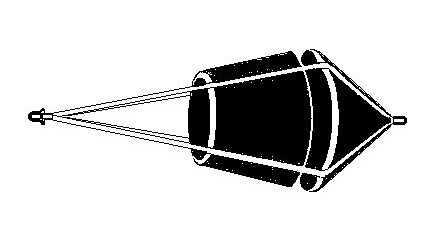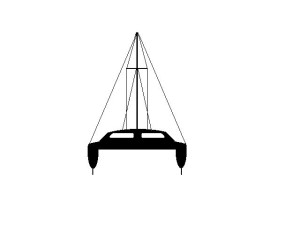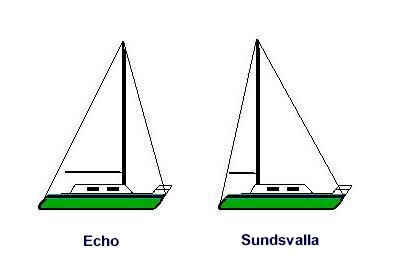S/C-12
Catamaran, Prout
39' x 18' x 9 Tons
18-Ft. Dia. Sea Anchor
Force 9-10 Conditions
File S/C-12, obtained from Sackville J. Currie, Blaney, Ireland - Vessel name An t-Iompodh Deisiol, hailing port Sligo, Ireland, "Escale" catamaran, designed by Prout, LOA 39' x Beam 18' x Draft 3' x 9 Tons - Sea anchor: 18-ft. Diameter Para-Tech on 400' x 5/8" nylon braid tether and bridle arms of 60' each, with 5/8" stainless steel swivel - Partial trip line - Deployed in a whole gale in deep water about 90 miles northeast of Casablanca, Morocco, with winds of 45-52 knots and seas of 15-18 ft. - Vessel's bow yawed 20-30° - Drift was estimated to be 7-8 n.m. during 36 hours at sea anchor.
Sackville J. Currie is the envy of every landlubber on the planet earth. Having sailed multihulls all over Japan as Prout's agent over there, he had the Prout brothers custom-design a 39-ft. Escale for himself, which he named An t-Iompodh Deisiol (pronounced Aan Umple Jesshul), Gaelic for "the place of turning sunwise."
After launching her in 1993 in Ireland he went on a three year - 18,000 mile - cruise. He sailed her down the Iberian Peninsula to North Africa, and then across the Atlantic to Brazil. After spending six months in Brazil, it was on to Venezuela, and then exotic Central American locations, and then the Leeward Islands, and finally onto Miami.
His article entitled Xcalac Con Escala, appearing in the November/December 1996 issue of Multihulls Magazine, gives the reader an inside view of what modern catamaran cruising is all about. Reading it will make any sailor's mouth water.
Imagine exploring the Caribbean on a seaworthy, handsome, luxurious, comfortable catamaran. Imagine swift passages to Trinidad and Tobago, Port of Spain, Bonaire and the Dutch Antilles, Curacao, Aruba, Cartagena, Bay Islands of Honduras and Roatan. Imagine a leisurely foray up Guatemala's Rio Dulce, which is navigable forty miles inland and is punctuated by numerous lakes that teem with gentle manatees. Imagine exploring the heart of the Central American rain forest on a spacious, ocean going catamaran, using twin diesels to power into mile-long winding canyons festooned with lush vegetation, cormorants, snowy egrets and thousands of green butterflies, to say nothing of running into the occasional lost Mayan city. Some people have all the luck.
Sackville's J. Currie's good luck is more than earned by his careful attention to details and planning, however. He knows the territory, so to speak, picking his routes and seasons carefully, always ready and prepared to run the unexpected gauntlet. And the gauntlets that Currie has run include a number of vicious ladies, among them Opal and Roxanne - hurricanes that devastated Yucatan and Guatemala in 1994. Currie barely managed to escape with the skin of his teeth.
Ah but then a miss is as good as a mile!
And as for the storms that he couldn't avoid, well that's what the parachute sea anchor was for. He deployed one in a nasty blow on the way to the Canaries from Casablanca. The bows of the Escale were yawing 20-30°, occasionally knocked to 40° by breaking waves. Currie said he was not worried about it, seeing how that it was a shock absorbing mechanism. (The yacht absorbs much of the shock of a breaking wave by pivoting on her CLR). A few lives were lost elsewhere in this storm. Transcript:
From Casablanca we set off for the Canaries. Within 24 hours the wind was up to F-7 on the nose, and still rising. Gale/storm lasted for 3 full days. For the first 12 hours we sailed into it to get searoom. About 95 miles off the African coast we hove to under staysail. The boat lay 50° off the wind and waves. Made 2 knots of drift, also took a lot of damage from waves crashing into our side (cockpit dodger broken, autopilot, wind instruments and GPS out of action). Once we deployed the parachute, we took waves on the bow, much better. The new deployment bag works very well. Motion on parachute was not nice though, we got seasick and some whip-lashing at stern.
We used a partial trip line with two fenders. The polypropylene trip line got twisted up - we will try a swivel here next time. In retrospect we should have deployed the parachute earlier, then we would have had no damage. To recover, we waited till wind and seastate moderated, then motored up to the fender.
We also use the parachute when we want a rest or when we have to go up the mast at sea, and to avoid nighttime landfalls, deploying it when still 20 miles offshore, and retrieving it in the early hours to allow arrival in daylight.


